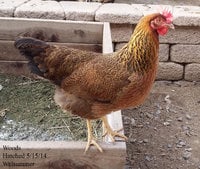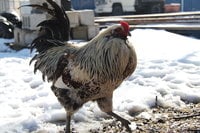I admit I didn't know much about Welsummer's when I got my chick from the clearence brooder of the feedstore. Here in the Pacific Nothwest, they don't seem to be as popular of a breed as Marans. Since I have had her for a year and a half, I can say she is definatly my favourite bird. My Welsummer is so friendly, anybody can pick her up and carry her like a baby. She does well with other chickens and who doesn't love those dark brown speckeled eggs. She is very pretty and just as naughty. She's often far too smart for her own good which means I have to take extra care to keep her out of my garden/vegatble basket. Cherry Tomato's have become her favourite. Though she doesn't get broody in the tradition sense, last night she slept in the nest box with my broody Maran. She even allowed the newly hatched chicks to sleep under her wing during the night. Her egg production is pretty good for not being a production breed. Unfortunatly, she starts molting in early September. This means egg production will be very spotty in October through November and will cease thorought December and January. When in peak laying season, she can easily compete with my Barred Rock when it comes to egg production. In my flock, she is the head chicken. She definately lets me know when a chicken is hogging the preferred nesting box - which my broody Maran does often.
Navigation
Install the app
How to install the app on iOS
Follow along with the video below to see how to install our site as a web app on your home screen.
Note: This feature may not be available in some browsers.
More options
You are using an out of date browser. It may not display this or other websites correctly.
You should upgrade or use an alternative browser.
You should upgrade or use an alternative browser.
Reviews by Afterburner
Filters
Show only:
Loading…
- Afterburner
- 4.00 star(s)
Pros: Friendly, reasonable good layer, do well in mixed breeds, very pretty dark eggs, beautiful plumage
Cons: Seem to molt very early in year, stop laying for 2-3 months in winter
- Purchase Price
- 1.99
- Purchase Date
- 2012-04-26
- Afterburner
- 4.00 star(s)
Pros: Quiet, pretty eggs, friendly, very inquisitive, assimilates well with other chickens.
Cons: No egg production from late November to early January in Pacific NW
Fun birds for backyards in suburban cities. Hens are fairly quiet and do not sing the egg song after laying. They 'roar' slightly, instead. They only sing when in danger or being bullied by other chickens. Egg production is very good for not being a dedicated layer. Here in Washington State, EE hens of all ages stop laying in late November and resume in January if additional lighting isn't provided. When temps get over 90 degrees F, they will pant and reduce laying.
- Purchase Price
- 10.00
- Purchase Date
- 2010-06-09
×


